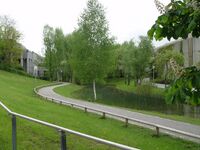University of Augsburg
Topic: Organization
 From HandWiki - Reading time: 4 min
From HandWiki - Reading time: 4 min
Universität Augsburg | |
 | |
| Motto | Scientia et conscientia |
|---|---|
| Type | Public |
| Established | 1970 |
| Budget | € 117.4 million[1] |
| Rector | Sabine Doering-Manteuffel |
Academic staff | 1,235[1] |
Administrative staff | 2,641[1] |
| Students | 20,437[1] |
| Location | Augsburg , Bavaria , |
| Campus | Suburban, Single-site campus |
| Website | www.uni-augsburg.de |
The University of Augsburg (German: Universität Augsburg) is a university located in the Universitätsviertel section of Augsburg, Germany. It was founded in 1970 and is organized in 8 Faculties.
The University of Augsburg is a relatively young campus university with approx. 18,000 students in October 2012. About 14% of its students come from foreign countries, a larger percentage than at comparable German universities.[2]
In October 2011 Sabine Doering Manteuffel succeeded Alois Loidl as rector of the university. She is the first female rector of a Bavarian university.
Organisation
The university is divided into 8 faculties:
- Faculty of Economics and Business (founded 1970)
- Faculty of Law (founded 1971)
- Faculty of Catholic Theology (founded 1971)
- Faculty of Philosophy and Social Sciences (founded 1972)
- Faculty of History and Philology (founded 1972)
- Faculty of Mathematics and Natural Sciences (founded 1981)
- Faculty of Applied Computer Science (founded 2003)
- Faculty of Medicine (founded 2016, in development)
Campus
The individual faculties, the administration offices (including the Student Service Centre), the refectory, cafeterias, bars, and the libraries are all close together.
History
The University of Augsburg was founded in 1970. It is one of the new, modern universities in Bavaria, and with approximately 18,000 (October 2012) students it is still of a manageable size. It attracts students from far beyond its immediate catchment area. About 20% of the German students come from outside Bavaria, and at 14% its share of foreign students is larger than at comparable universities.
The University of Augsburg maintains partnerships with the Universities of Pittsburgh (USA), Osijek (Croatia) and Iaşi (Romania), and the Far Eastern State University of Humanities, which is in Khabarovsk (Russia). It has cooperation agreements with over forty universities in Europe, Asia, South Africa, North America and Latin America. The number of ERASMUS exchange programmes also continues to grow. There are currently exchange programmes with more than 130 universities throughout Europe.
Anyone who has studied or carried out research here can keep in touch with the University of Augsburg once they have returned home. “Alumni Augsburg International” is a network for Augsburg students, too, as they can use it to find contacts.
University library
Augsburg University library consists of the central library plus libraries for social sciences, humanities and natural sciences. It was founded along with the university in 1969 and was at first situated in the ducal residence (Fronhof). In 1970, it was moved to the campus of the old university at Memminger Straße. The new central library on the current campus south of Augsburg opened in 1984.[3] The library comprises a total of some 2.0 million items (as of 2007).
Professional language teaching
The University of Augsburg's Language Centre provides tuition in modern languages. Students of philology receive practical language training in English, French, Spanish, Italian and Portuguese. In addition to this, the Language Centre offers courses specifically tailored to law and economics students, as well as the opportunity to study other languages such as Russian, Turkish or Japanese. Foreign students can improve their German language skills in tandem with their other studies. The University of Augsburg and the University of Applied Sciences work closely together in a joint testing centre for German as a Foreign Language (“TestDaF-Zentrum”), which tests the German language skills of international students.
Partnerships
The University of Augsburg has cooperation agreements with over 40 universities in Europe, Asia, South Africa, North America and Latin America. Particularly close partnerships are maintained with the following 4 universities
- University of Pittsburgh (United States)
- University of Dayton (United States)
- University of Osijek (Croatia)
- University of Iaşi (Romania)
- Far Eastern State University of Humanities, Khabarovsk (Russia)
Occupation and Protest 2009
On the 17. November 2009 over 500 students occupied the lecture room number 1 to call attention to the bad conditions in Augsburg and the entire German educational system.[4] Specifically, they protested against the need for university students to pay tuition fees and what they perceived as a decline in education quality in the German high school system.
They occupied the hall until the 22. December, using it as a plenary meeting room, holding discussions, organizing theatre and concert performances, showing films, and presenting their claims to the university administration and the Bavarian state. They agreed to end the sit-in because the university vice-president gave assurances that he would solve the problems, which are part of the university itself.[5]
Eventually, all German states scrapped the experiment with university tuition fees in public universities, after mass student protests.
See also
- List of colleges and universities
- Augsburg
References
- ↑ 1.0 1.1 1.2 1.3 "Wintersemester 2016/2017" (in de). https://www.presse.uni-augsburg.de/zahlen_fakten/ws1617/. Retrieved 2017-06-20.
- ↑ "University of Augsburg". http://www.uni-augsburg.de/allgemeines/portrait/englisch.pdf.
- ↑ Rudolf Frankenberger: Die Universitätsbibliothek Augsburg Augsburg 1970-1985. In: Bibliotheksforum Bayern 13 (1985), 6-22
- ↑ Augsburger Allgemeine: Augsburger Hörsaal fest in Studentenhand (recalled the 4th of July 2010).
- ↑ Augsburger Allgemeine: Augsburger Studenten räumen besetzten Hörsaal (recalled the 4th of July 2010).
External links
- University of Augsburg website (in German)
- English version of the website (in English)
[ ⚑ ] 48°20′02″N 10°53′54″E / 48.33389°N 10.89833°E
 KSF
KSF
